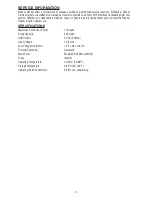
• If excessive heat is produced, this indicates the device should not be used with this inverter.
• This problem does not occur with most battery-operated equipment. Most of these devices use a separate
charger or transformer that is plugged into an AC receptacle.
• The inverter is capable of running most chargers and transformers.
MAXX SST
®
Soft Start Technology
®
Black & Decker’s Soft Start Technology gradually “ramps up” the inverters power to slowly start appliances that
require a surge to get started. This gradual ramp up protects the inverter and the appliance, as well as the
power source, from damage and failure.
OPERATING INSTRUCTIONS
Always connect the
BDI100
to the 12 volt DC power source before plugging any devices into the unit.
The standard AC and USB outlets allow simultaneous operation of multiple devices. Simply plug the equipment
into the unit and operate normally.
Ensure that the wattage of all equipment simultaneously plugged into the
BDI100 does not exceed 100 watts continuous.
Rated Versus Actual Current Draw of Equipment
Most electrical tools, appliances, electronic devices and audio/visual equipment have labels that indicate the power
consumption in amps or watts. Be sure that the power consumption of the item to be operated is below 100 watts.
If the power consumption is rated in amps AC, simply multiply by the AC volts to determine the wattage.
Resistive loads are the easiest for the inverter to run; however, it will not run larger resistive loads (such as
electric stoves and heaters), which require far more wattage than the inverter can deliver. Inductive loads (such
as TVs and stereos) require more current to operate than do resistive loads of the same wattage rating.
During engine cracking the voltage will drop below 10.5V and therefore shutdown the inverter. To reset the unit,
disconnect it from the 12 volt DC power source, leave for a few seconds and then plug it back in once the
engine has started.
Operation of the AC Outlet
1. Connect the unit to a vehicle’s accessory outlet or other 12 volt DC power source. Make sure there is
adequate space for proper ventilation of the inverter.
2. Rotate the plug slightly to make sure there is good contact.
3. The green LED light on the inverter will indicate proper operation.
4. If the inverter does not work, make sure the ignition/accessory switch is actually powering the accessory
outlet. Some vehicles require the ignition switch be turned on.
5. Plug the (CA) appliance into the Inverter’s AC outlet and operate normally.
Note: The Inverter will not operate appliances and equipment that generate heat, such as hair dryers,
electric blankets, microwave ovens and toasters.
Remember to disconnect the inverter from any power source when not in use.
Operation of the USB Charging Port
1. Connect the inverter to a functioning 12 volt DC power source as described in this Instruction Manual. Make
sure there is adequate space for proper ventilation of the inverter.
2. The Green Power LED Indicator will light, indicating a proper connection. Any fault condition will turn this
Green LED light off.
3. Plug the USB-powered device into the inverter’s USB Charging Port and operate normally.
Note: This unit’s USB Charging Port does not support data communication. It only provides 5 volts/500mA
DC power to an external USB-powered device.
Remember to disconnect the inverter from any power source when not in use.
Protective Features
The inverter monitors the following conditions:
Low Battery Voltage:
this condition is not harmful to the inverter but could damage the power source, so the
inverter automatically shuts down when input voltage drops below <10.5 ± 0.3 volts. When this condition is
corrected.
Over Voltage Protection:
the inverter will automatically shut down when the input voltage exceeds 15.5 ± 0.3
volts DC.
Short Circuit Protection:
the inverter will automatically shut down when short circuit occurs.
If the inverter’s fuse fails, disconnect the shorter load and replace the fuse inside the inverter. See “Fuse
Replacement” if a bad fuse is suspected.
19




































